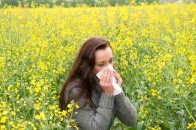Clinical Definition
Hay fever, also called seasonal allergic rhinitis or simply rhinitis, is the most prevalent type of allergy. It is caused by an IgE-mediated immune response to allergens that are airborne and inhaled. The condition is marked by sneezing, a runny nose and itching. Avoiding exposure to the allergen; taking over-the-counter or prescription medicines; or undergoing allergen immunotherapy can help to relieve hay fever. Hay fever can be seasonal or perennial.
In Our Own Words
Hay fever is also known as seasonal allergic rhinitis or plainly rhinitis. It is also commonly referred to as “allergies” by most people. Some authorities call both seasonal and perennial allergic rhinitis “hay fever”; others reserve hay fever for seasonal allergic rhinitis only. Regardless, the name hay fever is a misnomer, as it doesn’t involve hay or a fever. All forms of allergic rhinitis are reactions to an allergen. The condition is marked by sneezing, a runny nose and congestion, as well as itching.
Seasonal allergic rhinitis comes and goes with the seasons, as plants and fungi (i.e., mold) reproduce. When pollen and fungi spores are released into the air, those who are allergic to these allergens react. Perennial or year-round rhinitis can be caused by indoor allergens, such as dust mites, animal dander and molds.
Symptoms and Side Effects
- Sneezing
- Itching
- Runny nose
- Congestion
